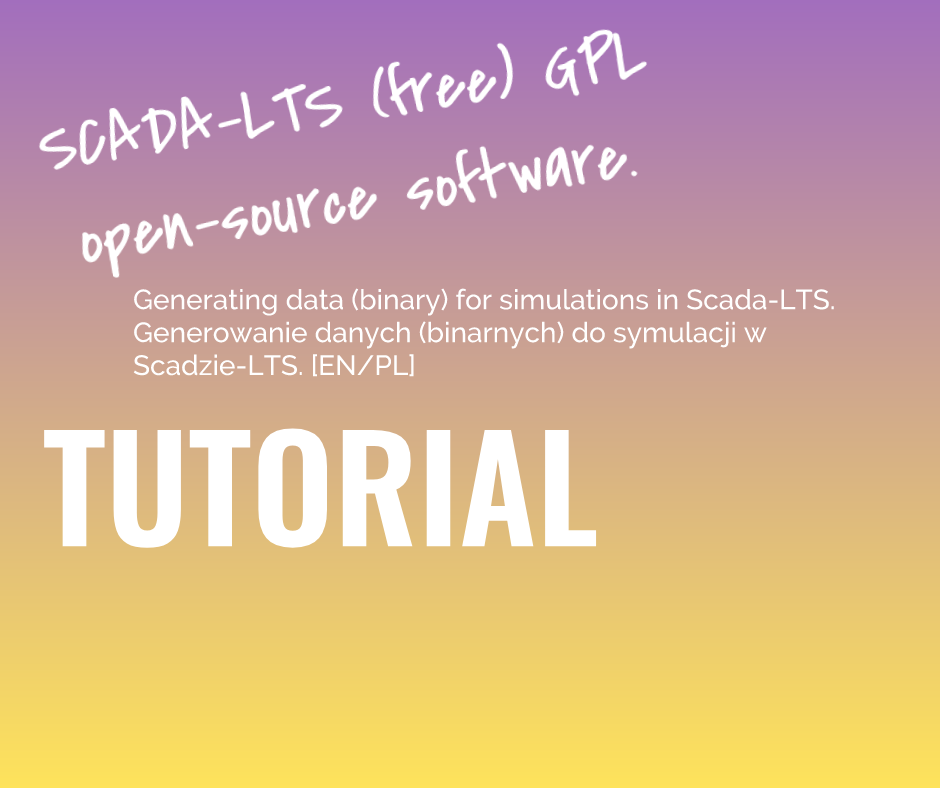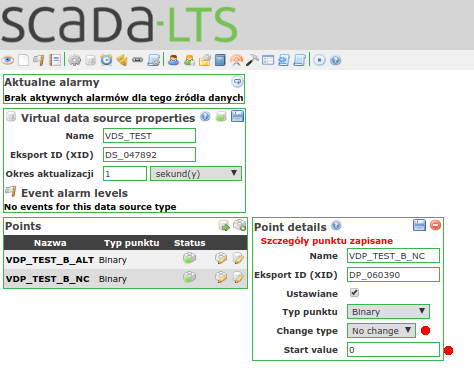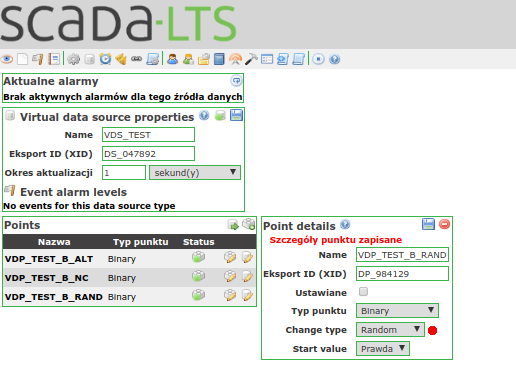Generating data (binary) for simulations in Scada-LTS / Generowanie danych (binarnych) do symulacji w Scadzie-LTS [EN/PL]

(EN) We will learn today to generate data (binary) for simulation in Scada-LTS.
In order to present data on HMI in our Scada-LTS system, connect alarms, create reports, we need data. Therefore, today I will describe how we can create a simulation of several measuring points in Scada-LTS.
Requirements
The Scada-LTS program is required for operation. Description of how to install Scada-LTS. To run the program, we need the Docker installed and a minimum of 4GB RAM on the Win / Linux system.
Difficulty (Advanced)
Virtual data source
We add measurement points in the appropriate "data sources", therefore we will first add a "virtual data-source".
- Go to the "data source" panel.
- We select the virtual data source "Virtual data source", we give the name VDS_TEST.
- We set the time for how much data should automatically be generated, e.g. 1 second.
- We save and enable the "data source".
Then add the points in the above-created VDS_TEST data source
- For the point, we can set 4 data types:
- binary (acts discussed),
- multistate,
- numeric,
- alphanumeric.
We can set the setable property which will allow us to change the point value from our program.
Depending on the type of data we have different ways to generate data, and so for a virtual point with type binary we have:
- Alternate - automatically changes values to true or false (within the time specified by data source)
- No change - does not automatically change the value
- Random - changes the random values true or false automatically.
Automatic means when the "data source" changes
Example of Virtual Point configuration - with Binary type and Alternate data change method.
Point - about the Binary type and the method of data change No change (does not change automatically).

A point - about the Binary type and how to change Random data.

Preview how data changes every second.
In the next part I will present the generation of data about type Multistate.
Links
- Description of the SCADA-LTS program
- [Generating binary data for simulation in Scada-LTS](The element of the tutorial - https://steemit.com/utopian-io/@grzesiekb/generating-data-binary-for-simulations-in-scada-lts-generowanie-danych-binarnych-do-symulacji-w-scadzie-lts-en-pl).
I invite you to subscribe:
- facebooka
- youtube channel
- my blog steemit
- and visiting the website scadalts.org
(PL) Nauczymy się dzisiaj generować dane (binarne) do symulacji w Scadzie-LTS.
Aby można było w naszym systemie Scada-LTS zaprezentować dane na HMI, podpiąć alarmy, stworzyć raporty, potrzebujemy danych. Dlatego dzisiaj opisze jak możemy stworzyć symulację kilku punktów pomiarowych w Scadzie-LTS.
Wymagania
Do działania wymagany jest program Scada-LTS. Opis jak zainstalować program Scada-LTS. Do uruchomienia programu potrzebujemy zainstalowanego Docker-a i minimum 4GB RAM-u na systemie Win/Linux.
Trudność (Zaawansowana)
Wirtualne źródło danych
Punkty pomiarowe dodajemy w odpowiednich "źródłach danych" dlatego najpierw dodamy "wirtualne źródło danych" (virtual data-source).
- Przechodzimy do panelu "źródła danych".
- Wybieramy wirtualne źródło danych “Virtual data source”, nadajemy nazwę VDS_TEST.
- Ustawiamy czas co ile mają się automatycznie generować dane, np 1 sekundę.
- Zapisujemy i włączamy "źródło danych".
Następnie dodajemy punkty w wyżej utworzonym źródle danych VDS_TEST
- Dla punktu możemy ustawić 4 typy danych:
- binary (dziaiaj omawiany),
- multistate,
- numeric,
- alphanumeric.
Możemy ustawić właściwość setable co pozwoli nam zmieniać wartość punktu z naszego programu.
W zależności od typu danych mamy różne sposoby generowania danych i tak dla punktu wirtualnego o typie binary mamy:
- Alternate - zmienia automatycznie wartości na zmianę true lub false (w czasie określonym przez data source)
- No change - nie zmienia automatycznie wartości
- Random - zmienia automatycznie losowa wartości true lub false.
Automatycznie to znaczy kiedy zmienia się "źródło danych"
Przykład konfiguracji Wirtualnego punktu - o typie Binary i sposobie zmiany danych Alternate.
Punktu - o typie Binary i sposobie zmiany danych No change (nie zmienia się automatycznie).

Punkt - o typie Binary i sposobie zmiany danych Random.

Podgląd jak zmieniają się dane co sekundę.
W następnej części przedstawię generowanie danych o type Multistate.
Linki
- Opis programu SCADA-LTS
- [Generowanie danych binarnych do symulacji w programie Scada-LTS](The element of the tutorial - https://steemit.com/utopian-io/@grzesiekb/generating-data-binary-for-simulations-in-scada-lts-generowanie-danych-binarnych-do-symulacji-w-scadzie-lts-en-pl).
Zapraszam do subskrybcji:
- facebooka
- kanału youtube
- mojego bloga steemit
- oraz na odwiedzenie strony scadalts.org
Posted on Utopian.io - Rewarding Open Source Contributors
Thank you for the contribution. It has been approved.
You can contact us on Discord.
[utopian-moderator]
Congratulations @grzesiekb! You have completed some achievement on Steemit and have been rewarded with new badge(s) :
Click on any badge to view your own Board of Honor on SteemitBoard.
For more information about SteemitBoard, click here
If you no longer want to receive notifications, reply to this comment with the word
STOPHey @grzesiekb I am @utopian-io. I have just upvoted you!
Achievements
Suggestions
Get Noticed!
Community-Driven Witness!
I am the first and only Steem Community-Driven Witness. Participate on Discord. Lets GROW TOGETHER!
Up-vote this comment to grow my power and help Open Source contributions like this one. Want to chat? Join me on Discord https://discord.gg/Pc8HG9x